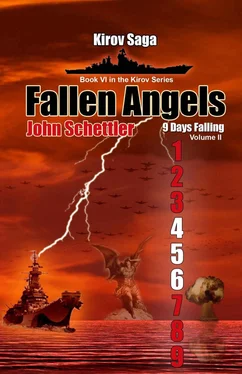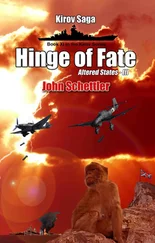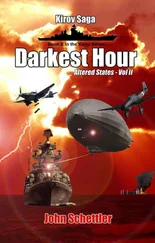“You’re talking about a strategic attack on Russian soil?”
“With conventional bombers and ordnance. No nukes.”
“Yes, but will the Russians see these bombers coming? Might they interpret this as a nuclear attack?”
“Sir, if we wanted to launch a surprise nuclear attack we wouldn’t start with the bomber leg of the triad. We’d lead with ICBMs and sea launched missiles. So yes, they might be able to detect the incoming strike package, even if we use the B-2s, but we think they would correctly interpret the attack as conventional.”
“Well I’m glad you’re confident about that, General, because it’s making me just a little bit nervous when we start sending strategic bombers over enemy airspace. Is there any way we can limit our operations to the areas presently involved in the conflict?”
“You mean Taiwan and the North Pacific? STRATCOM is the wrong tool for that job, sir. We’re here for deep strike missions. Admiral Ghortney?” Lane wanted support.
“I agree with General Lane,” the Admiral put in quickly. “We have two carrier battlegroups mustered now, and CVBG Washington will be able to hand off its viable assets to either one to strengthen those groups. These are the tools, to use the general’s word, that we’ll use to beat the Chinese over the head with a hammer to settle this Taiwan business. The Strike Warfare Commanders and working with the Air Tasking Orders for Taiwan now. There was no way I was going to send the Eisenhower in to the South China Sea on its own after we saw what happened to Tanner on Big George. This time we will group our naval assets and use them in close coordination with one another. The Chinese have demonstrated some interesting and formidable capabilities. If we’re going to settle this matter, we’ll need everything we have in theater.”
“What about the Russian fleet?” Leyman was looking at his latest briefing on the matter.
“We think they’re down for the count—nothing we need concern ourselves with in the short run, except for the boomers. Those are the SLBM subs capable of launching missiles at the US from off shore. Thus far this business hasn’t escalated to an all out war at sea, but that’s where it’s headed. If this thing winds up any tighter, they’ll be after our boomers, and we’ll be after theirs, and I mean all over the globe.”
“The President is hoping we can limit this to the Pacific—to Taiwan and the Chinese.”
“Those hopes have already gone up in smoke, Mister Leyman.” Ghortney was not one to mince words. “The Russian 58th Army crossed the border into Kazakhstan this morning. They’re already operating to seize the oil fields in that region, and with the Persian Gulf up in arms, that matters. There’s also been an incident in the Black Sea involving British ships, not to mention that sucker punch in the Gulf of Mexico when they took a pot shot at that oil platform.”
“Thunder Horse? Yes, that one hurt us.”
“At least we got the damn sub, so they paid for that attack. The point I’m making is that the gloves are coming off. The Chinese have already gone after our satellites. The Russians and their proxies like Iran have hit strategic energy infrastructure that we rely on wherever they can find it. This is no longer a gentleman’s war. It’s time we get serious and let them know what they’re up against. It’s time we pushed back—and hard.”
“Very well….” Leyman looked from Ghortney to Lane. “Just what do you propose we do?”
“Hardkill SEAD will begin the operation,” said Ghortney. “We’ll use the Tomahawk Land Attack Cruise Missile and other similar assets off both surface and subsurface naval units, and from aircraft as well.”
“Seed?”
Ghortney spelled it for Leyman. “Suppression of Enemy Air Defense,” he explained. “We hit their known SAM sites and radars. That clears the airspace for the second wave that General Lane will be sending.”
“My bombers are ready,” Lane said quickly. “We lead with the B-2 strike and take out their satellite launching facilities. The B-1s can then be tasked against the airfields they are now using to support operations against Taiwan. We can pound them with more cruise missiles, smart bombs, and take those fields down in 24 hours. Then Admiral Ghortney might have something further to say about things.”
Ghortney nodded. “The next task would be establishing air superiority over Taiwan. CVBG Washington is down for the count at the moment, but I’ve got Nimitz and Eisenhower ready to move west, and we’ll hold Tanner’s remaining assets in the Washington group as a reserve until Third fleet reinforces us. CVBG Bush is already heading for Pearl Harbor. That will give us sufficient naval air power to restore order in the skies over Taiwan, and once we do that, the Chinese will think twice about the troops and equipment they’re loading on their amphibious shipping. We need to move quickly, and hit hard if they begin cross channel operations.”
Reed cleared his throat. “Excuse me, Admiral, but what about the DF-21s?”
“What about them?”
“The Chinese know their trump card is the ballistic missile. Look how they went to it right at the outset when they tangled with the Japanese. You move those carriers west and you might be looking at DF-21’s trying to make a clam chowder out of your operational zone.”
Reed had put his finger on the strategic crux of the matter. The aircraft carrier had reigned supreme in naval strategy since it proved itself in the Second World War. Now, for the first time, the threat of ballistic missiles was posing a grave challenge to carrier dominance. Just as the capabilities of carrier launched planes had ushered in the demise of the battleship, now ballistic missiles threatened to dethrone the carrier.”
“Well, Mister Reed,” Ghortney put it as straight as he could. “We’ll just have to see about that, wont we. We’ll just have to pound those missile sites to dust as well.”
“TheKA-226 is reporting in now, sir,” said Rodenko. “We have good long range radar returns on the American battlegroups to the south. It appears that they are bringing up another large flotilla.”
“Show me.” Karpov leaned heavily on the rim of the radar panel as Rodenko pointed out the contacts.
“I’ll have the data transferred to the tactical board, sir. This looks like yet another carrier task force—at least ten capital ships, and communications has intercepted ship-to-ship radio traffic. Nikolin believes Admiral Halsey is commanding.”
“That would agree with Fedorov’s books,” said Karpov.
“Yes, well I’m reading 34 additional ships in this group. Add those to the units we are already tracking and we are now facing no less than 60 enemy warships of various types.”
“Nine carriers, four battleships and three heavy cruisers,” said Karpov matter of factly. “That is if the historical data is accurate. The rest are light cruisers and destroyers.”
“We have 62 SSMs, sir.” Rodenko’s eyes conveyed the obvious admonition. “That is not enough conventional weaponry to effectively oppose a force of this size. And those carriers will likely have hundreds of aircraft available.”
“Correct.” Karpov was pacing now, thinking and considering his situation. It was shaping up very much like those last frantic moments off the coast of Newfoundland when the ship was faced with multiple enemy task groups. The weapons tally was no more favorable then, and he had determined that stronger measures were necessary. Why was he hesitating now?
“How long before those ships might threaten us with another air strike?”
Читать дальше











